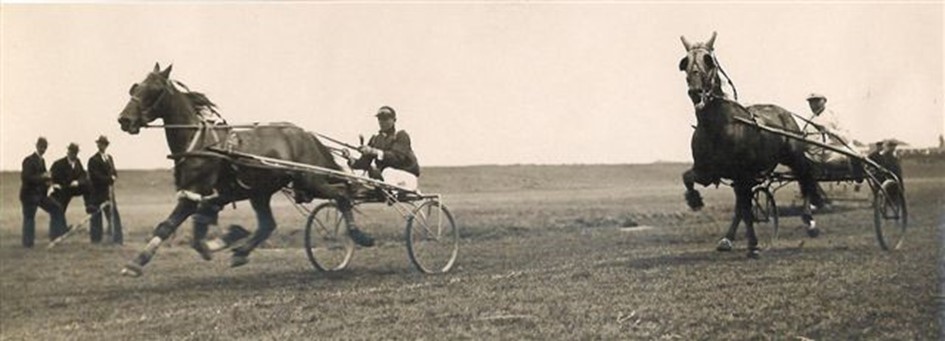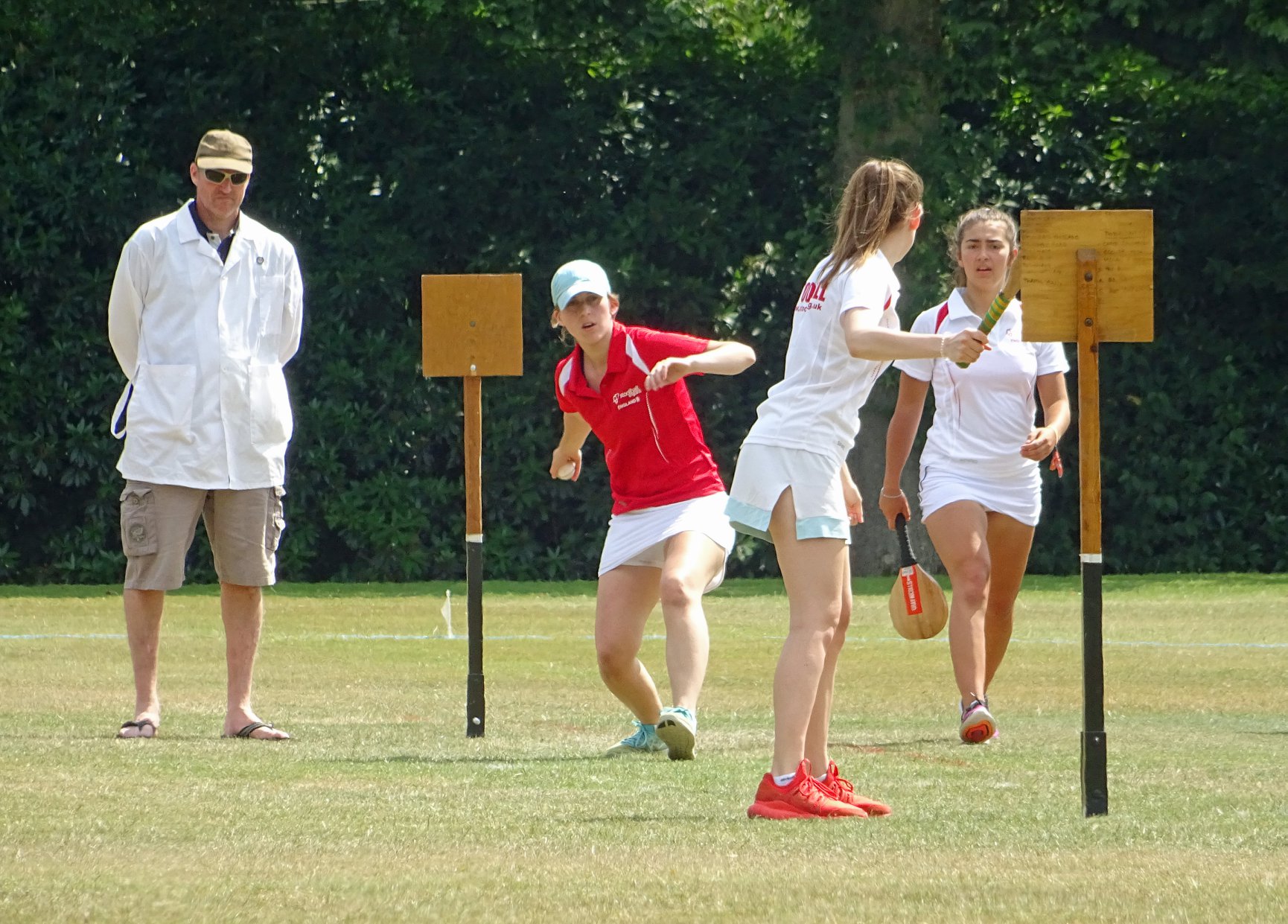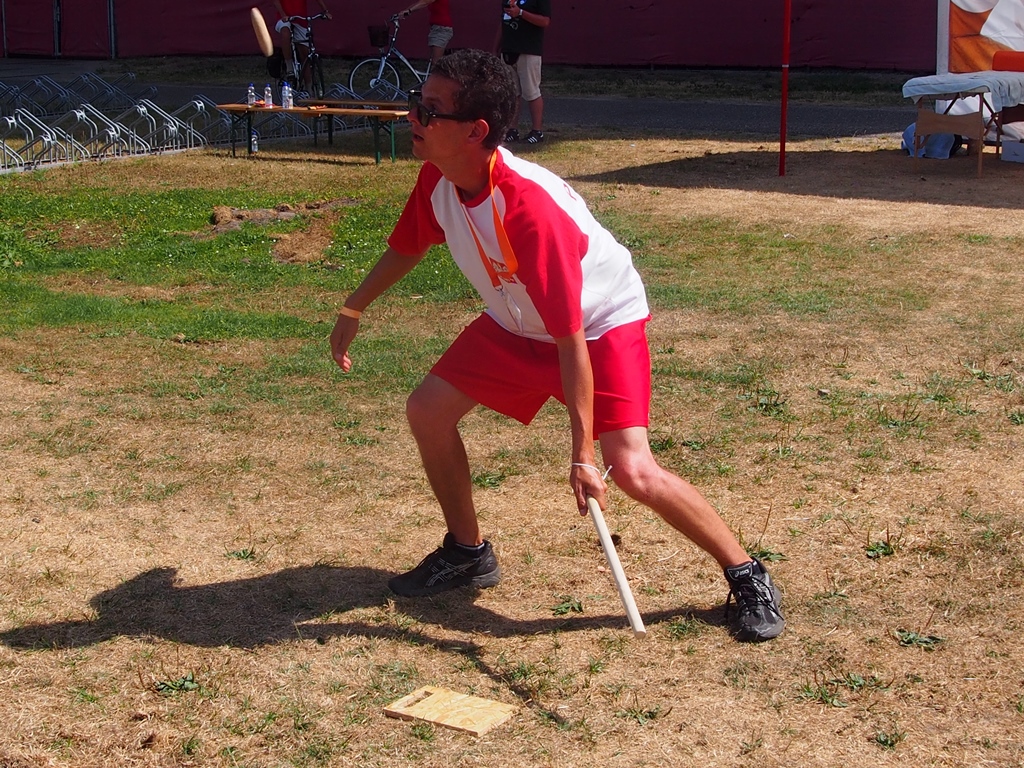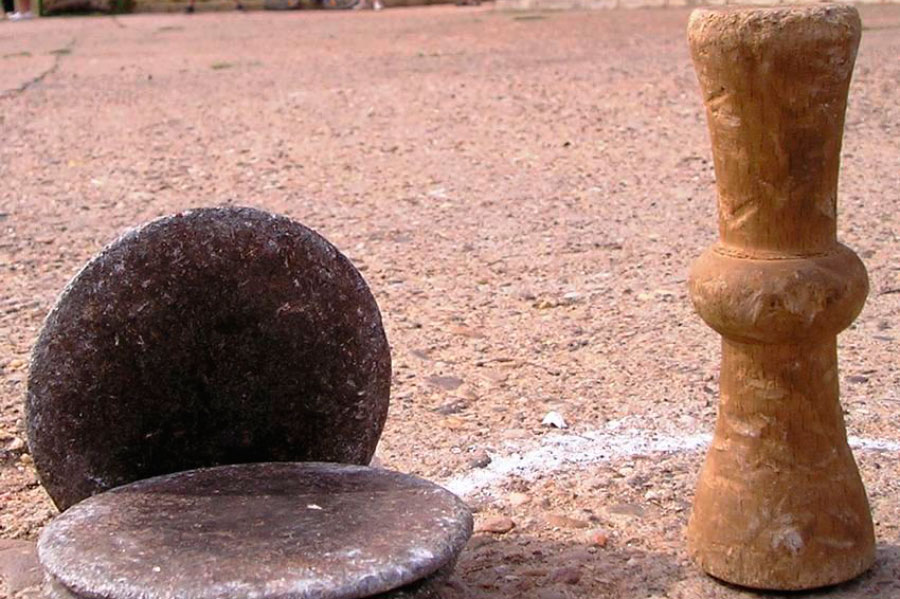- Sources of information :
Artykuł:
https://www.archiefndr.nl/HtmlHistKortebanen/KbStompwijk.htmSource of photos used in this article and gallery:
https://www.archiefndr.nl/HtmlHistKortebanen/KbStompwijk.htm - Gallery:
- Name of sport (game): Stoolball
- Name in native language: Stoolball
- Place of practice (continent, state, nation):
Stoolball is a bat and ball game now played mainly in the counties of Sussex, Kent and Surrey (England).
- History:
It has its origins from at least the 15th century and some argue that cricket is derived from stoolball. It is game for both sexes: both adults and older children.
The origins of the game, and indeed its name, comes from placing milking stools on the ground and defending them with a hand. The stools were also suspended from trees.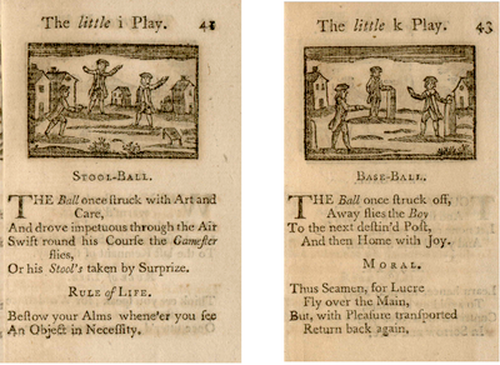
The game we know as baseball may be relatively modern, but it has medieval roots. Many bat-and-ball games were played throughout the Middle Ages at religious festivals and events. One game, stool ball (sometimes possibly stow ball, or stob ball, or stump ball) dates back at least to the 14th century, and many historians believe that it is the common ancestor of both baseball and cricket. It was also the first bat-and-ball-type game known to have been played in North America (at Plymouth in 1621 at Christmastime, no less, much to the chagrin of Governor Bradford). In this game, the pitcher tries to hit a stool or stump with the ball, while the batter tries to defend the target using bare hands or a bat.
Stool ball was known for being played by both women and men together, and there are indications that it was a sort of springtime ritual, played at Eastertime. Some of the poetic mentions of the game imply an undertone of sexuality; "playing at stool ball" was used at least once as an euphemism.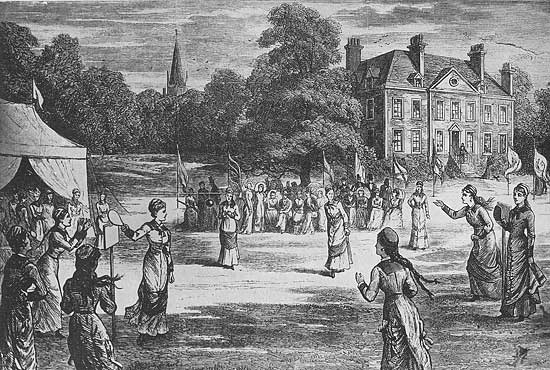 The Ancient National Game of Stoolball - A Match at Horsham Park', The Gazetter, 1878
The Ancient National Game of Stoolball - A Match at Horsham Park', The Gazetter, 1878
In many stool ball games, tansy-cakes were the traditional winners' prize. Tansy-cakes were a traditional Eastertime food, so this is another connection of stool ball to Easter celebrations.
Unfortunately, no one knows exactly what the rules of the period versions of stool ball were. Since it was a folk game, it was likely to have varying rules at various times and places. From post-period references to the game, we know that in some versions of the game, there was no bat, and bare hands were used instead. Other versions had no baserunning, just a single stool or stump base that the batter was expected to defend. But bats and running the bases were included in some versions, too.
(https://slumberland.org/sca/articles/stoolball.html)In the following centuries the rules were formalised and the stools replaced with the wickets mounted on posts or stakes. There was a great revival during the First World War when the game was thought suitable for the recuperating wounded soldiers and even a match was placed at Lord's, the home of cricket, in 1917.
The game remained popular until the Second World War when social changes meant a decline in its popularity.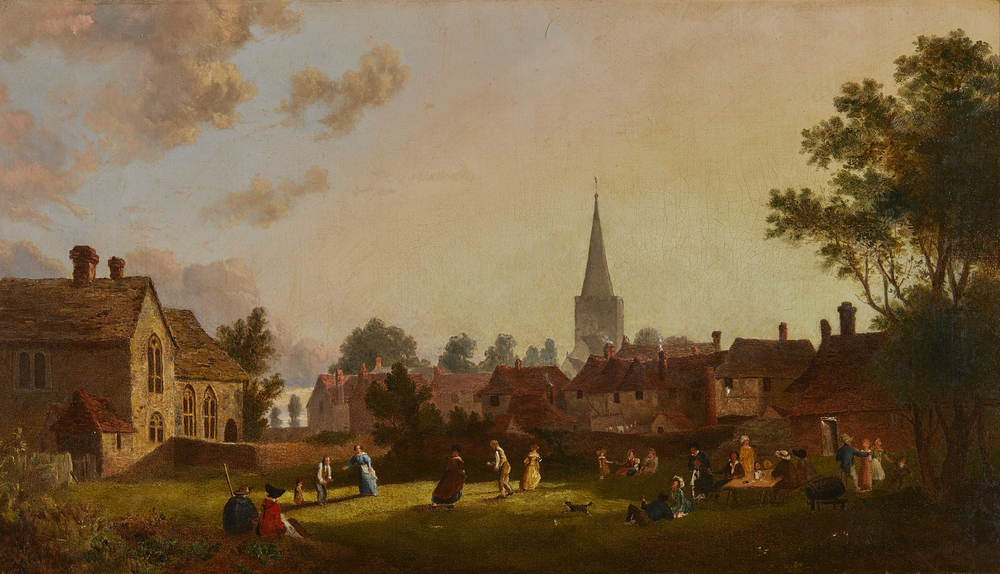
Edward Martin, A game of Stoolball at West Tarring, Sussex, 1856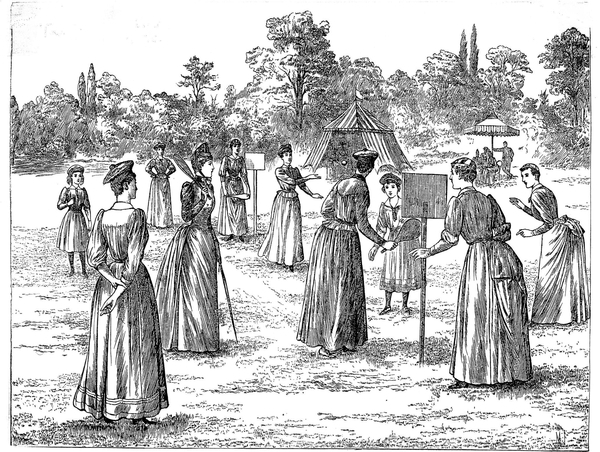
Drawing of stoolball from Girls Own magazine, 1891 - Description:
Like cricket it has eleven players-a-side who play in much the same positions. The wickets are a square board of wood on top of a wooden post or stake. The batter defends the board with a bat shaped rather like an elongated table tennis bat and made of willow. The wickets are sixteen yards apart.
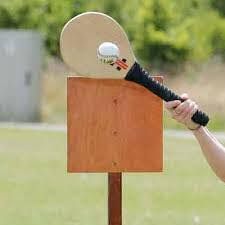
The bowler, and this is what make the game so suitable for all, can only bowl underarm to try and to hit the wicket. The batsman meanwhile has to try and hit the ball and score runs by running between the wickets. There are eight balls an over.
The pitch is smaller than cricket - 90 yards diameter - and does not have to be level, which harks back to its earliest origins when in the 15th century there were complaints of the game being played in churchyards after Sunday service.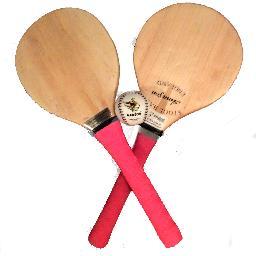
- Current status:
Practiced
- Importance (for practitioners, communities etc.):
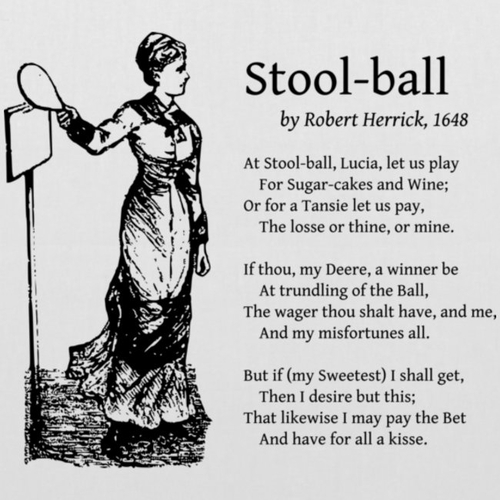
- Contacts:
Stoolball England
https://www.stoolball.org.uk/This email address is being protected from spambots. You need JavaScript enabled to view it.
tel.: +44 7708 197740
Ditchling Stoolball Club
https://www.facebook.com/ditchlingstoolball/
Tel.: 07967383735
http://www.ditchlingstoolballclub.co.uk/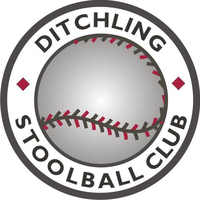
West Kent Ladies Stoolball League
https://www.facebook.com/West-Kent-Ladies-Stoolball-League-787407521290700/This email address is being protected from spambots. You need JavaScript enabled to view it. 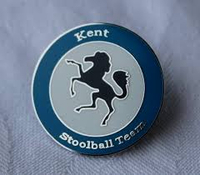
Worthing Ladies Stoolball Club
Tel: 01903 261806
Email :This email address is being protected from spambots. You need JavaScript enabled to view it. 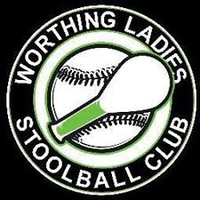
Fletching Stoolball Club
Email:This email address is being protected from spambots. You need JavaScript enabled to view it.
Fb: https://www.facebook.com/Fletching-Stoolball-Club-142009162676382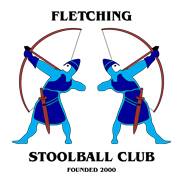
Stedham Stoolball Club
Fb: https://www.facebook.com/stedham.stoolballclub.5 - Sources of information :
Articles:
https://lordgreys.weebly.com/articles-and-features/stool-ball
https://slumberland.org/sca/articles/stoolball.html
https://protoball.org/Stoolball_Today_--_The_Rejuvenation_of_an_Ancient_Pastime
https://www.mastersofgames.com/rules/stoolball-rules.htmVideo:
https://www.youtube.com/watch?v=pcbHImoLms0
https://www.youtube.com/watch?v=KWjKYR3HIt4
https://www.youtube.com/watch?v=13kbcbjekBY
https://www.youtube.com/watch?v=ekpXrfLJeG4
https://www.youtube.com/watch?v=ITqskvM7HAw&feature=emb_logoSource of photos used in this article and gallery:
https://www.sportingheritage.org.uk/content/what-we-do/projects/the-sporting-heritage-of-disability-and-womens-sports/stoolball-what-ball-history-of-the-traditional-rural-womens-sport - Gallery:
- Documents:
 Dimensions_of_a_stoolball_pitch.pdf
Dimensions_of_a_stoolball_pitch.pdf
- Name of sport (game): Sztekiel
- Name in native language: Sztekiel
- Place of practice (continent, state, nation):
Poland – it used to be played in several regions of Poland, having different names, such as, among others, klipa, kiczka, pliszka, czyż or sztekiel. There are also similar games in other countries all over the world, like tip cat in England, mouilh in French Brittany, Guli Dunda in Pakistan, India or Bangladesh, pandolo in Slovenia etc.
- History:
Sztekiel belongs to a large, international family of games. It was played in Poland especially in the villages by poor youth in western Poland. It was developed into many variations. After the First World War it started to disappear. After the Second World War mass sport was popularized in Poland and most of simple, folk games as sztekiel were no longer popular.
- Description:
Sztekiel is a very simple, hitting and throwing game.
In its basic version, a player uses a flat or a rounded bat to hit a small, wooden, sharpened at both ends, stick up in the air and then he/she knocks it again forwards into the field as far as possible.
There were many regional variations of this game. In more complex versions, the game consisted of several rounds in which the points were awarded for hitting a stick further into the field than the opponent. These points were calculated in different ways. The winner was the player who scored more points in the entire game or the one who just hit the stick the furthest. - Current status:
Sztekiel is no longer a popular game. However, it has not disappeared completely.
Until fairly recently, from time to time, the competitions in sztekiel were organized, in which the graduates of the Ignacy Paderewski Secondary School in Poznań from the 1950. (called "Kadra" (the Team)) were playing, supported by the current pupils of this secondary school and the students of the Poznań University of Physical Education. The matches were played in a friendly, recreational atmosphere. They even enjoyed the interest of the regional media.
The prizes in these competitions were decoratively varnished, hand-made sticks (called in plural form “sztekle”). Sometimes you could also hear about these competitions in regional radio stations and newspapers. There is even a unique book, edited by Henryk Walendowski and his friends, entitled “The sounds of our class”. It includes an interesting column, describing sztekiel - its history, rules of the game, competition results, etc. It has a symptomatic name “szteklology”.
Sztekiel is also occasionally presented in Poland and abroad. This sport enjoyed some interest, for example, in… South Korea during the TAFISA World Sport for All Games, where in 2008 this game was shown by workers and students of the Poznań University of Physical Education.
In addition, it is also played from time to time in some museums, like the Museum of the First Piasts in Dziekanowice, Greater Poland region. - Importance (for practitioners, communities etc.):
Sztekiel as a the Post-war "game of freedom".
It may seem that sztekiel is “just a game”. However, after the Second World War, this sport was much more important, especially in many villages in Greater Poland. It was then that people raised their heads after the terrible years of war turmoil, and the game of sztekiel turned out to be one of their liberating “tools”.
The former sztekiel player and a deserved initiator and organizer of the competitions in sztekiel, the creator of the game equipment and the editor of studies devoted to it, Henryk Walendowski, told us: “For us it was a sport of freedom. In a city full of a post-war rubble, we would go to the field and play sztekiel. It was an opportunity for us to meet and have
a genuine sense of freedom after the war".
Currently, the above-mentioned matches of “the Team” are organized less frequently than in the past. Sztekiel also does not have a large range of influence in Poland. The hope lies in the younger generation that this Polish game will not be forgotten. In other countries, similar games are returning and receiving some attention. Hopefully, it will be the same for sztekiel. - Contacts:
Bartosz Prabucki, PhD, expert in traditional sports, Institute for the Development of Sport and Education.
- Sources of information :
W. Lipoński, World Sports Encyclopedia, MBI, OW ATENA, St. Paul-Poznań, 2003.
Website: https://inspirowanysportem.pl/sztekiel-ciekawa-gra-powojennego-pokolenia-polakow/ - Gallery:
- Name of sport (game): La Tanguilla
- Name in native language: The denomination tanguilla is the one commonly used in the town of Palazuelos and, in general, in the mountains of the north of the province of Guadalajara and nearby areas of Segovia and Soria.
- Place of practice (continent, state, nation):
Spain
- Description:
It is a game of aiming or "precision throwing" and depending on the locality it receives various names: tanga, tarusa, tuta, cairn, tangana, canutillo, etc.
The game requires three elements: the players, the yews and the tanguilla itself.
The tanguilla is a cylinder about 18 or 20 centimeters long and 3 or 4 centimeters in diameter, with perfectly smooth bases.
The yews are metal disks between 8 or 10 centimeters in diameter and about 4 or 6 millimeters thick. The dimensions and composition determine its weight, an important factor in the game. In certain localities, yew trees are also called "tangones" or "chocones".
To play, choose an elongated and flat surface, as hard as possible (although it retains a small upper layer of sand). At one end the tanguilla is placed vertically and a circle is delimited around it. At about 20 meters is the minimum limit for players to position themselves for the launch. - Sources of information :
Video:
https://www.youtube.com/watch?v=SB_wSfBwBuI
The information contained in the article comes from the following sources:
https://www.youtube.com/watch?v=SB_wSfBwBuISource of photos used in this article and gallery:
https://www.diariodelaribera.net/hemeroteca/deportes/en-busca-de-un-nuevo-logotipo-para-conmemorar-su-25-aniversario/ - Gallery:
- Name of sport (game): Tiro de Barra
- Name in native language: Tiro de Barra
- Place of practice (continent, state, nation):
Aragon, Spain
- Sources of information :
Articles:
https://www.fanyanas.com/2011/08/el-tiro-de-barra-en-fananas-y.html
https://diarioaragones.com/el-tiro-de-barra-un-deporte-ancestral-que-sobrevive-hasta-nuestros-dias/?fbclid=IwAR3S5AfAEwj4GhG4Jukc6oDFaqlw94-xmamIRbAh0_9pV811amkNgqHguFg

